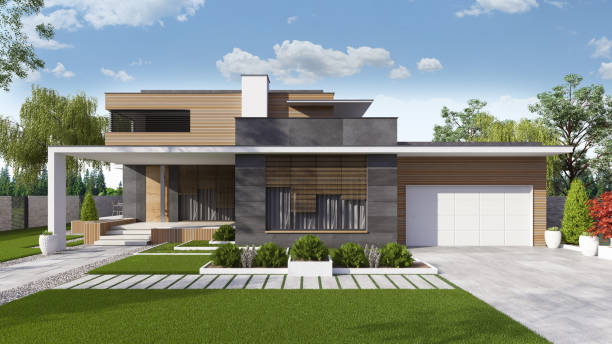Welcome to the “2023 House Rendering Cost Guide,” where we embark on a comprehensive journey to unveil the intricacies of how much does rendering costs for your home. As the year unfolds, understanding the financial aspects of rendering becomes crucial for homeowners and those planning renovations.
In this guide, we will delve into the factors influencing rendering expenses, provide insights into different rendering types, and offer valuable tips to help you make informed decisions about transforming your house into a visually stunning and durable masterpiece.
Join us as we navigate the landscape of rendering costs in 2023, ensuring you are well-equipped to make the right choices for your home improvement projects, including insights on interior design rendering costs.
Understanding Rendering Basics
What is Rendering, and Why is it Important?
The exterior walls of a structure are rendered to protect them. This covering, called render, protects the building from the elements. Rendering protects your property from rain, wind, and other natural influences by blocking moisture.
Rendering improves your home’s appearance. A sleek, finished look hides cracks, crumbles or construction material defects. Rendering improves insulation and reduces heating and cooling costs in addition to aesthetics.
Different Renders and Their Uses
Renders meet varied demands and preferences. A conventional and durable alternative for most structures is cement render, made of sand, cement, and lime. Silicone render is a modern alternative with flexibility, breathability, and crack resistance. Monocouche renders single-layer applications elegant and modern.
Each render type has different uses depending on the building’s location, beauty, and maintenance. Understanding these distinctions helps you choose the best render for your needs.
The Effect of Rendering on Home Appearance
The rendering process affects your home’s appearance as well as its functionality. Your property’s character and curb appeal depend on render type, colour, and finish. Finishes might be smooth, textured, or patterned to reflect your taste and the architecture of your surroundings.
The quality of the rendering work the companies offer also matters. A professionally done rendering project can give a house a unified and polished appearance. It adds value and beauty to your property as well as protection. Understanding the rendering process helps you make informed decisions for a durable, attractive, and well-protected home exterior.

How Much Does Rendering Cost: A Comprehensive Guide
To accomplish a successful and affordable house rendering job, prices must be carefully considered. This detailed guide explaining rendering expenses helps you make a smart financial plan.
Labour, Materials, and More Average Costs
Budgeting requires cost breakdown knowledge. Labour and materials account for most interior design rendering costs. Labour costs comprise the professional staff needed to apply the render, while materials include the render type, colouring agents, and any extras. By breaking out these expenditures, homeowners can better budget money and avoid project financial surprises.
Influences on Rendering Prices
Several factors affect house rendering pricing, increasing project costs.
- The property size
- Render type
- Scaffolding need
- Quality of existing walls
- Architectural design
- Customised requirement
This section explains the many aspects that affect rendering prices to help homeowners make informed selections based on their specific needs.
You Need a Detailed Cost Guide for Your Rendering Project
The rendering process benefits from a precise pricing guide. It guides homeowners through expected costs and prevents financial surprises. A good cost guide estimates labour, supplies, amount of coats, extras, and eventualities.
It helps homeowners determine realistic budgets, get accurate contractor bids, and make informed project selections. Creating and following a clear expense guide is crucial to planning and executing a successful rendering project.
This comprehensive guide helps homeowners approach their rendering job with financial certainty and foresight by examining the average cost breakdown, factors affecting rendering prices, and the importance of a specific cost guide.
Building Regulations and Planning Permits
Building Regulations Impact Rendering
Building codes provide structural integrity and safety. These restrictions help ensure that rendering your home follows standards. Building codes govern everything from material selection to application. Compliance protects your rendered surfaces from legal issues and prolongs their life.
Ensuring Legal Compliance for Smooth Rendering
Legal compliance is key to a seamless rendering process. Before starting a rendering project, check local building codes and get planning permission. Failure to follow these regulatory requirements might lead to project delays, fines, or costly changes.
By proactive compliance, you provide a smooth rendering journey without surprises or legal issues. It’s a proactive approach that ensures project success and home structural and cosmetic integrity.

Picking the Right Render Color and Finish
Significance of Color in Rendering
Colour affects the mood and appearance of your home in house rendering. The Right coloured render can enhance architecture, match landscaping, and alter property size. Colour selection should take into account your neighbourhood’s palette and home design. Bold colours can offer a modern edge, while earthy tones are classic. Beyond aesthetics, colour in rendering contributes to environmental harmony.
Different finishes affect home aesthetics
The render finish you choose can transform your home. Smooth, textured, patterned, or uniformed finishes each have their effect. Textured coatings give individuality, while smooth finishes are modern and elegant. Consider your home’s architecture and desired look. Texture can also affect how light interacts with your walls, adding subtle details to the appearance.
How to Match Your Render to Your Home's Style and Environment
Your render should match your home’s style and surroundings for a desirable look. Consider your home’s brickwork or timber cladding and choose a render complimenting it. Consider the climate, landscape, and local building styles. Matching your render to your home’s design and surroundings makes it part of its setting and creates a beautiful and harmonious living place.
Wall Rendering Techniques and Considerations
Wall Rendering Types and Structure Suitability
One size doesn’t fit all for wall rendering. Understanding wall rendering kinds is essential for aesthetic and functional results. Sand and cement rendering is a durable and classic finish for many constructions.
However, silicone and acrylic render are flexible and weatherproof, making them appropriate for modern constructions. Climate, property architecture, and desired visual impact should influence render type.
Benefits of External Wall Insulation
External wall insulation improves energy efficiency and comfort beyond aesthetics. This method insulates outside walls to reduce heat loss and energy use. Better thermal performance, lower energy bills, and more stable indoor temperature are the benefits. For older buildings that lack insulation, external wall insulation is a modern way to improve energy efficiency without sacrificing aesthetics.

Cavity Walls Render and Insulate
The gap between two bricklayers, or cavity walls, is vital to rendering and insulation. Thermal insulation materials can be installed in this gap, improving thermal efficiency. Choose a render type that works with cavity walls when rendering a property. After properly filling the cavity with insulation, a render is applied.
This improves energy efficiency and provides a smooth, durable finish. Cavity walls and proper rendering create a weatherproof barrier, ensuring the structure’s longevity.
Explore Rendering Materials and Methods
Materials and methods used to render your home affect its durability, appearance, and performance. This section covers conventional and current 3d rendering technologies, including sand and cement rendering and silicone and acrylic rendering.
Old-fashioned sand and cement rendering
Pros:
- Durability: Sand and cement rendering is durable and long-lasting.
- Cost-effectiveness: Traditional procedures are cheaper, making them appealing to individuals on a budget.
- Material:Sand and cement render works on brick, block, and concrete substrates.
Cons:
- Cracking: Sand and cement render can develop hairline cracks, especially in structurally active areas.
- Flexibility: It fractures more easily in harsh weather because of its lower flexibility than newer alternatives.
Silicone and Acrylic Render Are Modern.
Pros:
- Silicone and acrylic render are flexible enough to accommodate building motions without cracking.
- These new choices repel water, preventing dampness and extending render life.
- Silicone and acrylic render offer more colour and finish options for homeowners.
Cons:
- Modern rendering materials are more expensive than previous ones, which may affect the project budget.
- Silicone and acrylic render are difficult to apply, so a professional is suggested.
Rendering Project Material Selection
Your needs, money, and aesthetic preferences determine whether to use classic or modern rendering resources. For durability and affordability, sand and cement rendering may be best. Silicone or acrylic render may be better for flexibility, water resistance, and aesthetics.
Consult a rendering professional to assess your property’s needs and recommend the best material for a successful and attractive project.

Damp Problems: Prevention and Solutions
Homeowners fear damp concerns because they destroy structures and property. Before rendering, moisture issues must be addressed and prevented. This section discusses Identifying Damp Problems Before Rendering and how the rendering method might prevent them.
Pre-Rendering Damp Problem Identification
Damp issues must be assessed before rendering walls. Water stains, peeling paint, and mustiness are indicators. Inspect your home’s interior and exterior brickwork, paying special attention to moist areas like basements and plumbing. Early detection of these issues ensures a robust rendering basis.
Using Rendering to Prevent and Fix Damp
To avoid dampness in walls, rendering functions as a moisture barrier. Rendering’s sealed surface greatly reduces water ingress. Rendering can also seal cracks and prevent water penetration if damp conditions arise. Choosing a water-resistant render like silicone render is crucial to damp prevention and resolution.
Ensure Long-Lasting Render Against Damp
To ensure your render’s lifespan and damp resistance, choose a high-quality material and precise application methods. Proper surface preparation, including dampness removal, is crucial.
In addition, adding a damp-proof membrane before rendering strengthens the render against external moisture. Maintaining the render by examining and fixing cracks and damage quickly assures its long-term damp resistance.
Finally, moisture issues must be addressed during rendering. Fixing issues before rendering, choosing the proper materials, and applying the render precisely prevent moisture and extend the life of your home’s exterior.
Quality Repairs and Maintenance Matter
Calculating Existing Render Repair Costs
Assessing your current render is crucial when considering a house rendering project. Repair expenses for existing damage are calculated first. This evaluation should consider damage kind, extent, impacted area size, and restoration materials. An expert assessment may provide an accurate quote, ensuring your budget matches the repairs.
Repair Methods for Different Damage
Render damage can range from cracks and chips to major concerns. Maintaining render integrity requires knowing how to repair different sorts of damage. Minor cracks may be patched with the right filler, while greater damage may need rendering over the affected region. Matching the repair method to the damage guarantees a smooth restoration.
Maintaining Your Render Helps It Last
Render longevity depends on preventative maintenance. This includes regular inspections, cleaning, and rapid problem-solving. Avoid harmful accumulation by washing dirt, mould, and pollutants regularly. Checking for water intrusion and fixing any issues will protect your render from further harm. Home care routines that include regular maintenance extend the life of rendered walls.
Finally, quality house rendering repairs and upkeep are crucial. Calculating repair costs, using proper methods for different damage types, and maintaining your render regularly can ensure it remains visually good and durable for years.

Exploring Pebbledash and Roughcast
The Beauty of Pebbledash and Roughcast
Pebbledash and roughcast render treatments give your home’s exterior a unique texture. A rustic and fascinating facade is created using pebbledash, little stones in the render. Roughcast uses gravel or stones to create a more textured surface. Both styles give character and dimension to your property’s appearance by departing from smooth renders.
These Unique Render Styles: Costs and Considerations
While pebbledash and roughcast provide a striking exterior, they also have prices and drawbacks. Pebble and aggregate types and sizes affect costs. Due to the complexity of applying textured finishes, labour expenses may be greater. The initial cost should be weighed against the long-term esthetic impact and particular charm these finishes add to dwellings.
Fixing Pebbledash and Roughcast Finishes
Pebbledash and roughcasts require maintenance to maintain their appeal. Moss and algae can damage render over time, so regular cleaning is essential. To avoid water damage, cracks and chips must be repaired immediately. Repairs should use matching materials to maintain finish uniformity. Professional advice on render style maintenance can help homes maintain a durable and attractive façade.
Planning: Rendering Calculator
Some Advantages of Using a Rendering Calculator
Investment in a rendering project involves careful financial planning, and a rendering calculator is important. Its capacity to instantly clarify expenses is a major asset. You may quickly get a detailed estimate by entering your home’s size, render type, and additional features. Transparency helps you make informed decisions and understand your project’s financial scope.
Moreover, a rendering calculator allows scenario comparison. You can test different options and see how they affect cost by changing variables. This dynamic feature lets homeowners customise the project to their budget without sacrificing quality.
Specific Project Cost Estimation
Gathering project information before using a rendering calculator is simple. Start by entering the area to be rendered, the render type (sand and cement or silicone), and any additional characteristics like colouring or finishes. After receiving these inputs, the calculator will estimate.
Scaffolding, local labour expenses, and wall condition should be considered. These details affect the ultimate pricing. By considering these aspects, you can improve your estimate and better reflect your project’s financial needs.
Planning Your Budget Accurately and Ahead
Budgeting is crucial to rendering project success, and a rendering calculator gives the precision needed. With an exact estimate of the total cost, you may plan your budget ahead of time and avoid financial shocks. This proactive strategy guarantees enough finances and allows for adjustments and contingencies.
A well-calibrated budget helps you bargain with contractors and suppliers. Understanding the project’s financial scope allows you to have informed discussions, enabling transparency and collaboration.
A rendering calculator provides transparency, scenario comparison, and realistic estimations, making it a critical planning step. By using this tool, you can prepare for a well-budgeted and profitable rendering job.
Key Takeaways
- Rendering is essential for protecting your home from the elements, improving its appearance, and enhancing insulation.
- Adhering to building regulations and obtaining planning permits is crucial for a smooth rendering process.
- Property size, render type, scaffolding needs, wall quality, architectural design, and customisations influence rendering costs. A detailed cost guide is essential for homeowners to budget effectively and prevent financial surprises during the project.
Conclusion
Navigating the 2023 House Rendering Cost Guide has highlighted the intricacies of rendering expenses and their influencing factors. Understanding the diverse range of rendering options and their likely costs empowers homeowners to make informed decisions aligning with their preferences and budgets.
Whether opting for traditional renders or embracing the modern appeal of advanced finishes, this guide is a valuable resource in demystifying the interior design rendering cost landscape.
As the architectural world continues to evolve, homeowners can embark on rendering projects with confidence, knowing that a well-informed approach ensures not only an aesthetically pleasing exterior but also a cost-effective investment in the longevity and value of their homes. Additionally, for those wondering, “How much does rendering costs,” this comprehensive guide provides insights for a transparent decision-making process.



